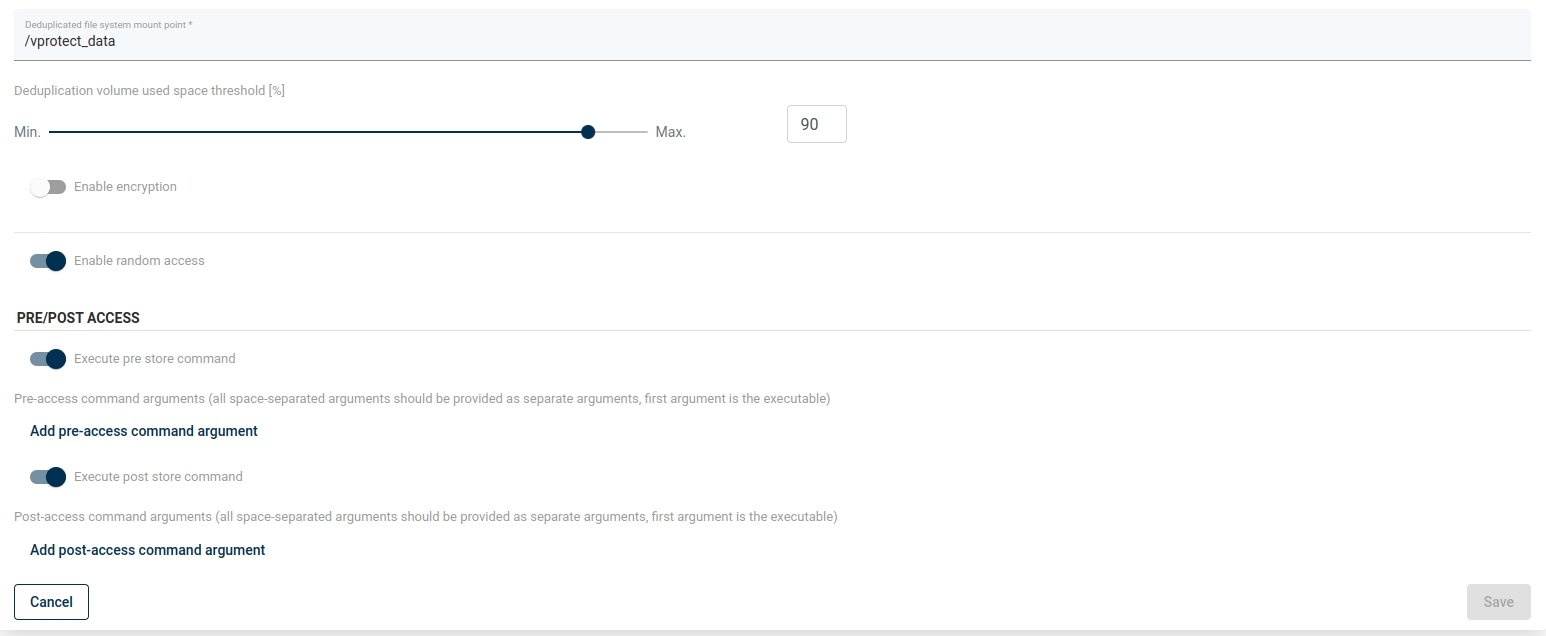Backup Destinations
A backup destination is a storage location where vPlus keeps VMs, Containers, Cloud, and applications backup copies. To configure a backup destination, you can use the following storage types:
The backup destination is defined by the backup provider configuration and retention settings. Each policy can be backed up to the selected backup destination. Backup destinations must be assigned to the nodes in the node configuration.
Retention
Pre- / post-access command execution
Prepare your scripts
the pre-script is invoked before every access to the Backup Destination - common usage - create and mount the remote volume
the post-script is executed after Node finishes store, restore, and clean-up operations
The following environment variables are set before each execution - you can use them later in your scripts:
VP_VM_GUID- GUID of the VM in vPlusVP_VM_UUID- UUID of the VM used by the hypervisor or hypervisor managerVP_VM_NAME- the name of the VMVP_VM_TMP_DIR- path to the folder containing files in the stagingVP_BD_GUID- GUID of the Backup Destination being accessedVP_BD_NAME- the name of the Backup Destination being accessedVP_CONTAINER_NAME- standard container name generated by vPlus that can be used for names of the volumes (format<VM-NAME>__<PART-OF-UUID>, for exampleCentos 7__8d3ef6f1, may contain special characters)VP_EXPORT_PATH- an export path from Node Configuration, can be used as the mount root for backup destination volumesVP_TASK_TYPE- the name of the task type, e.g.:STORE/RESTORE/DELETE_VM/OLD_BACKUPS_REMOVAL- to distinguish operation type when scripts are being invoked
Upload your scripts to the node, where the
vprotectuser is able to access themOptionally, you may need to add a new file in the
/etc/sudoers.d/directory to enable thevprotectuser to execute privileged script (like chown operations in some file system locations):%vprotect ALL=(root) NOPASSWD: /opt/vprotect/scripts/myscripts/privileged.shOpen the "BACKUP DESTINATIONS" section from the left menu:

Open your Backup Destination (click on the name)
Provide pre- / post-access command arguments (the first argument is the command executed locally on the node):

Encryption
Filesystem
Yes
vPlus Node
Generated based on metadata in the database. Separated keys are generated per object.
Automatically
AES
Filesystem (synthetic, XFS)
No
n/a
n/a
n/a
n/a
isoLayer (synthetic, XFS)
n/a
n/a
n/a
n/a
n/a
PowerProtect DD
Yes
vPlus Node
Generated based on metadata in the database. Separated keys are generated per object.
automatically
AES
Huawei OceanProtect
Yes
vPlus Node
Generated based on metadata in the database. Separated keys are generated per object.
automatically
AES
MS Azure Blob Storage
Yes
vPlus Node
Generated based on metadata in the database. Separated keys are generated per object.
automatically
AES
Amazon S3
Yes
Server Side (Backup Destination own mechanism, not managed by vPlus)
Generated based on metadata in the database. Separated keys are generated per object.
automatically
n/a
S3 compatible
Yes
Server Side (Backup Destination own mechanism, not managed by vPlus)
Generated based on metadata in the database. Separated keys are generated per object.
automatically
n/a
Cloudian S3
Yes
Server Side (Backup Destination own mechanism, not managed by vPlus)
Generated based on metadata in the database. Separated keys are generated per object.
automatically
n/a
Alibaba Cloud OSS
Yes
Server Side (Backup Destination own mechanism, not managed by vPlus)
Generated based on metadata in the database. Separated keys are generated per object.
automatically
n/a
Nutanix Objects
Yes
Server Side (Backup Destination own mechanism, not managed by vPlus)
Generated based on metadata in the database. Separated keys are generated per object.
automatically
n/a
OpenStack Swift
Yes
Server Side (Backup Destination own mechanism, not managed by vPlus)
Generated based on metadata in the database. Separated keys are generated per object.
automatically
n/a
Scality Ring
Yes
Server Side (Backup Destination own mechanism, not managed by vPlus)
Generated based on metadata in the database. Separated keys are generated per object.
automatically
n/a